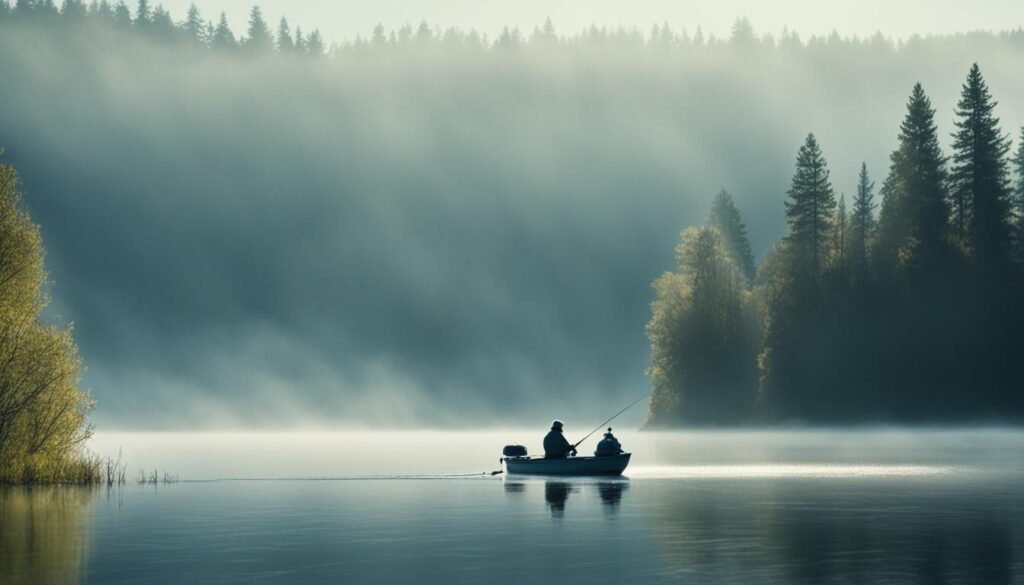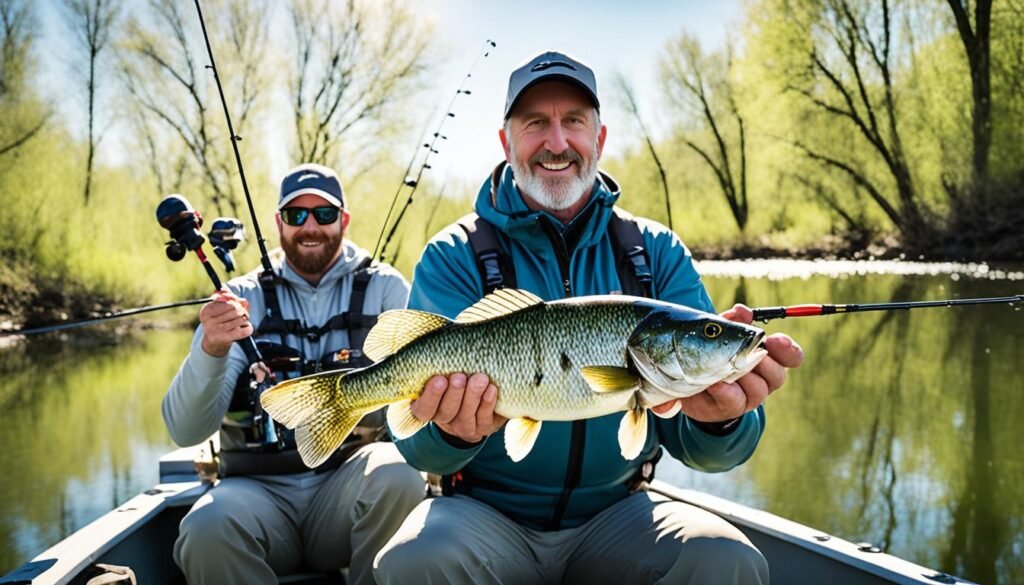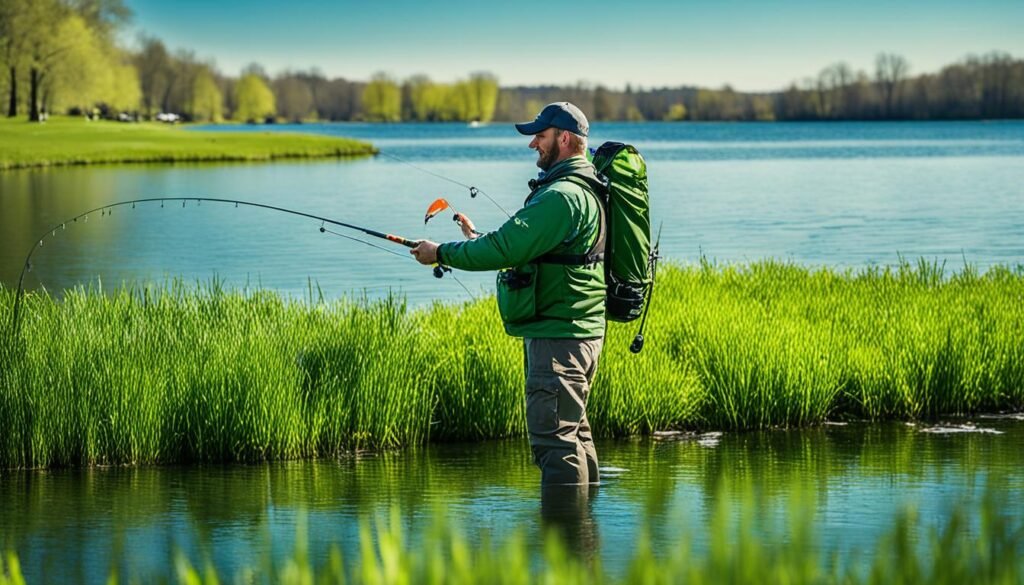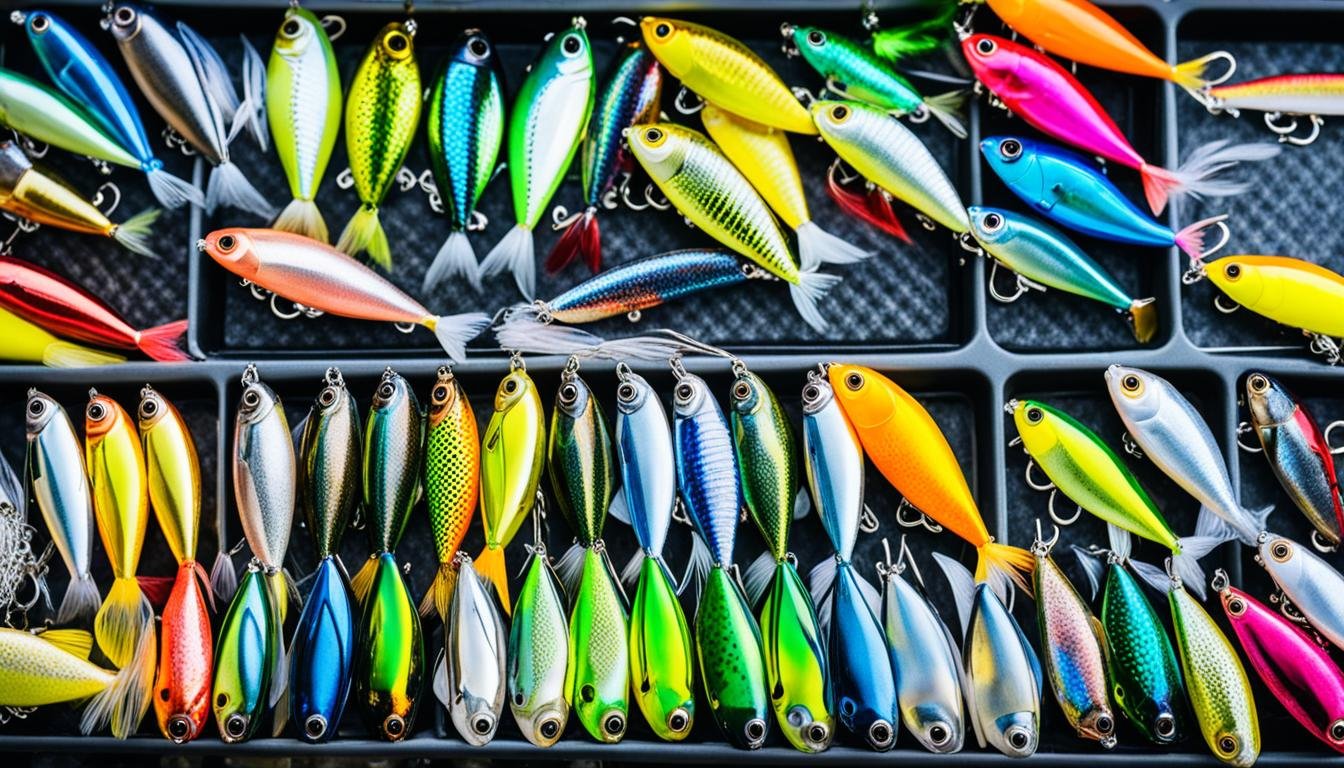Are you a Canadian angler looking to expand your fishing repertoire beyond traditional methods?
Discover how casting artificial lures can unlock a whole new world of opportunities to consistently catch more and bigger fish in your local waters.
We’ll dive into expert tips and techniques that will have you rethinking your approach to Fishing with Artificial Lures, Bass Fishing, Lure Techniques, Fishing Tackle, and Freshwater Angling.
Key Takeaways about Fishing with Artificial Lures
- Explore the benefits of casting artificial lures for increased catch rates and bigger fish
- Master versatile presentation and retrieval techniques with crankbaits, jigs, spinnerbaits, and soft plastics
- Discover productive spring fishing opportunities for species like lake trout, northern pike, and crappie
- Learn how to effectively fish for perch using artificial lures for easy and rewarding spring outings
- Stay up-to-date on the latest lure releases and refine your terminal tackle for maximum success
The Benefits of Casting Artificial Lures
When it comes to fishing, the debate between using artificial lures and live bait has long been a topic of discussion among anglers. However, for those seeking to improve their catch rates and land larger fish, casting artificial lures can offer a distinct advantage.
One angler, who wished to remain anonymous, shared his remarkable experience: “In the past five years, I’ve caught more big walleye by casting lures than I did in the previous five years combined. In fact, around 80% of my trophy-sized fish were caught this way.” This impressive statistic highlights the potential of casting techniques to produce impressive results.
Increased Catch Rates and Bigger Fish
Casting artificial lures can be a game-changer for anglers seeking to enhance their fishing success. The versatility of lures allows for a more varied presentation and retrieval, enabling anglers to experiment and find the most effective techniques for a given day or location. This adaptability can be particularly advantageous when targeting larger fish, as it allows anglers to fine-tune their approach to match the prevailing conditions and fish behavior.
Versatility in Presentation and Retrieval Techniques
The ability to cast artificial lures provides anglers with a multitude of options when it comes to presenting their offerings to the fish. From slow, steady retrieves to fast, erratic movements, the range of casting techniques available can help trigger the predatory instincts of wary fish, leading to more consistent and successful walleye fishing experiences.
“Casting artificial lures allows me to cover more water and experiment with different actions to find what the fish are responding to best on a given day. It’s a game-changer for my fishing success.”
In conclusion, the benefits of casting artificial lures are clear: increased catch rates, the potential to land larger fish, and the versatility to adapt to changing conditions and fish behavior. For anglers seeking to maximize their time on the water, mastering the art of casting lures can be a valuable skill to develop.
Early Spring Fishing Opportunities

As the Canadian winter starts to release its icy grip, early spring presents a host of exciting fishing opportunities for anglers. Two prime targets during this transition period are lake trout and northern pike, both of which can be effectively targeted using a variety of artificial lures.
Lake Trout Tactics with Swim Jigs and Minnow Baits
Lake trout tend to be near the surface within two to three weeks of ice-out, making them easily patterned and caught with various artificial lures like swim jigs and minnow baits. These aggressive predators are often found in the shallower waters of lakes, providing an excellent chance for anglers to target them with these versatile presentations.
Targeting Big Northern Pike in Feeder Bays
Meanwhile, northern pike can be a prime target in the early spring, with anglers finding success by focusing on newly emerging weed beds and feeder bays. Due to the cooler water temperatures, these big, predatory fish may be more sluggish, requiring the use of smaller baits and slower retrieves to entice strikes.
By understanding the early spring patterns of these two popular gamefish, Canadian anglers can capitalize on these exciting fishing opportunities and enjoy the thrill of landing hard-fighting lake trout and northern pike on artificial lures.
Crappie Fishing in Spring

As the warm spring weather arrives, crappies emerge from their winter hideaways, making them a prime target for anglers across Canada. These prized panfish congregate around wood, docks, lily pads, reeds, and newly emerged weed beds, eagerly anticipating the spawning season. To effectively present lures to these spring crappie, the article recommends a small, sensitive float rig with 1/32 or 1/16 oz jigheads tipped with creature baits, minnows, or tubes.
Float Fishing with Small Jigs and Plastics
The Baby Shad is described as the standard for spring crappie fishing, suggesting its popularity during this fishing season. This versatile bait can be fished in various ways, making it a go-to choice for many anglers.
The Slab Slay’R, available in two sizes, with the 2-inch version being a preferred option among crappie anglers, showcases the demand for smaller profile lures. Similarly, the Pile Diver, despite its diminutive 2 ½-inch size, offers significant vibration and a large profile, appealing characteristics for attracting crappie.
For those seeking an even smaller presentation, the Slab Hunt’R at 2 ¼ inches is noted for looking larger than expected, underscoring its visual impact as a fishing bait. The Crappie Shooter, measuring in at just 1.5 inches, is suitable for use with light jigheads, making it a versatile option for float fishing in the spring.
| Lure | Size | Key Features |
|---|---|---|
| Baby Shad | – | Standard for spring crappie fishing, versatile presentation |
| Slab Slay’R | 2 inches | Preferred size among crappie anglers |
| Pile Diver | 2.5 inches | Offers significant vibration and large profile |
| Slab Hunt’R | 2.25 inches | Looks larger than expected, impactful visual appeal |
| Crappie Shooter | 1.5 inches | Suitable for use with light jigheads |
By incorporating these small jigs and soft plastics into a sensitive float rig, anglers can effectively present their lures to the actively spawning crappie, increasing their chances of a successful and rewarding spring crappie fishing experience.
Spring Perch: Easy and Rewarding

As the ice melts and the waters warm, Canadian anglers eagerly await the arrival of a true spring fishing sensation – the humble yet captivating yellow perch. Known for their vibrant colors and tasty fillets, perch are a popular target for both novice and experienced anglers alike. This spring fishing opportunity is not only easy to access but also highly rewarding, making it a must-try for any outdoor enthusiast.
Perch can be found spawning in a wide range of habitats, from shallow bays and coves to deeper, open-water areas. This versatility allows anglers to target them using a variety of techniques, from simple float rigs tipped with live bait to more specialized jig and float presentations. For those seeking an even more active approach, soft plastics have become a popular choice, mimicking the natural forage that perch seek out.
One of the best aspects of spring perch fishing is its accessibility. Anglers of all skill levels, including families with young children, can enjoy the thrill of reeling in these feisty fish. The combination of their aggressive feeding behavior and the variety of effective fishing methods make perch an ideal target for anglers looking to create lasting memories on the water.
Whether you’re targeting perch in the shallows with a jig and float rig or fishing deeper holes with a simple live bait setup, the spring season presents a wealth of opportunities to get out and enjoy the sport of fishing. So, grab your gear, head to your nearest lake or river, and get ready to experience the rewarding pursuit of spring perch.
Fishing with Artificial Lures

When it comes to Soft Plastic Lures, the manufacturing process plays a crucial role in their performance and appeal to fish. Two primary methods dominate the lure production landscape: hand-poured baits and injection-molded baits.
Understanding Soft Plastic Lure Manufacturing
Both hand-poured and injection-molded Soft Plastic Lures utilize plastisol, a vinyl-based plastic, as the primary material. This versatile substance can be manipulated to create baits with varying degrees of softness and firmness, allowing anglers to precisely match the desired action and texture to their target species and fishing conditions.
Hand-Poured vs. Injection-Molded Baits
- Hand-poured Soft Plastic Lures offer greater customization, as the manufacturing process allows for unique shapes, colors, and scents to be incorporated. This artisanal approach, however, can be more time-consuming and labor-intensive.
- Injection-molded baits, on the other hand, leverage automated machinery to produce lures in a more efficient and cost-effective manner. While the design options may be more limited, the consistency and production speed of this method make it appealing for many lure manufacturers.
Ultimately, the choice between hand-poured and injection-molded Soft Plastic Lures comes down to personal preference and the specific needs of the angler. The manufacturing method is less important than selecting the right plastic formulation to achieve the desired action and mimic the targeted forage.
“The key to successful fishing with Soft Plastic Lures is understanding how the manufacturing process can impact the lure’s performance and choosing the right option for your specific fishing needs.”
Selecting the Right Lure Texture and Firmness
As Canadian anglers venture out for spring fishing, the selection of the right lure texture and firmness becomes crucial. These factors not only mimic the targeted forage but also play a vital role in achieving the desired lure action that entices fish to strike.
Soft-plastic fishing lures are commonly made from plastisol, a vinyl plastic that can be manipulated to change its durometer (firmness) by adjusting the ratio of resins and plasticizers. This versatility allows anglers to choose baits that closely resemble the local forage, whether it’s a wriggling nightcrawler, a pinching crayfish, or a slender baitfish.
Mimicking Forage and Achieving Desired Action
The texture of a soft-plastic bait is crucial, as it can influence how long a fish holds onto the lure. A soft, supple texture may mimic a nightcrawler, while a firmer, more rigid profile can represent a crayfish or small baitfish. The lure firmness also affects the lure action, as baits that are too soft or too firm may fail to demonstrate the ideal swimming or pulsing motion that triggers strikes.
“Soft-plastic lures can take on a new shape if not stored properly, requiring careful packaging to maintain their original form.”
Hand-poured soft-plastic baits were historically perceived as superior to injection-molded baits, but advancements in manufacturing processes have made both methods capable of producing equally soft and lifelike lures. Anglers should stay informed on the latest developments in the soft-plastic lure market to ensure they are using the most appropriate lure texture and firmness for their target species and fishing conditions.
By understanding the nuances of lure texture and firmness, Canadian anglers can more effectively mimic the local forage and achieve the desired lure action to entice more strikes and land bigger fish this spring.
Keeping Up with New Lure Releases
In the ever-evolving world of fishing lures, anglers must stay informed and adaptable to maximize their success on the water. The constant stream of new soft plastic lure introductions can be both exciting and overwhelming, but by leveraging the power of research and experimentation, Canadian anglers can find the most effective baits for the fish species they target.
Research and Experimentation for Success
Magazines, books, videos, and TV shows often feature lure fishing prominently, but the reality is that more anglers use natural baits than artificial lures on a daily basis. This perception can be misleading, as the most successful anglers usually start with natural baits before transitioning to lures or fly fishing, indicating the importance of bait fishing for foundational skills.
To stay ahead of the curve, anglers should take the time to research the latest New Lure Releases and study the nuances of Lure Research and Lure Experimentation. This can involve reading industry publications, scouring online forums, and even connecting with local tackle shop owners or fishing guides to gain valuable insights.
However, it’s crucial to avoid feeling overwhelmed by the constant stream of new products. The most successful anglers often keep it simple by focusing on a few proven lure styles and colors, while also experimenting with terminal tackle modifications to find the optimal presentation for their target species.
“The Original Floating Rapala remains the company’s best-selling lure and continues to be highly regarded by anglers, even today.”
By striking a balance between staying informed and maintaining a selective approach, anglers can navigate the ever-changing landscape of fishing lures and find the New Lure Releases that will help them land more and bigger fish throughout the spring and summer seasons.
| Lure Brand | Product Name | Key Features | MSRP |
|---|---|---|---|
| Berkley | Dime | Weight transfer system in smaller sizes 4 and 6 for further casting | – |
| Berkley | Nessie | Available in 5-inch, 7-inch, and 9-inch sizes | – |
| Rapala | Crush City Bronco Bug | Available in 15 colors | $6.99 |
| Rapala | Crush City Freeloader | 4 1/4 inches long, 6-pack, 17 custom colors | $6.99 |
| Strike King | Gravel Dawg | Available in Gravel Dawg 8 and Gravel Dawg 10 sizes | – |
| Strike King | KVD J300 Deep Sinking Jerkbait | – | $11.99 |
| Strike King | Mr. Crappie Bitsy Splash | Available in 1/16 oz., 1/8 oz., 1/4 oz., and 3/8 oz. | $5.99 |
| Bill Lewis | The GNAT | 1 1/2-inch long, 1/8 ounce, 8 fish-catching colors | – |
Terminal Tackle Refinement
For Canadian anglers seeking to maximize the effectiveness of their artificial lures, the careful selection and fine-tuning of terminal tackle is crucial. From hooks and weights to innovative rigging techniques, small adjustments can make a significant impact on the performance and action of your lures, ultimately leading to increased catch rates and larger fish.
Hooks, Weights, and Rigging Techniques
Experimenting with different hook sizes and shapes can greatly influence how a soft plastic lure behaves in the water. A smaller, more compact hook may provide a more natural presentation, while a larger, wider gap hook can enhance hook-up ratios. Thoughtful weight placement is also crucial, as it can dramatically alter the lure’s action and help it mimic the movements of natural prey.
Innovative rigging techniques can further refine the performance of your lures. Incorporating features like split rings, swivels, and bead chains can add subtle yet impactful movements, while the strategic use of rubber bands and wire leaders can improve lure durability and prevent line twist.
By experimenting with various terminal tackle components and rigging methods, anglers can dial in the perfect presentation for their target species and waterways, giving them a distinct advantage on the water.
“Proper terminal tackle selection and rigging can be the difference between a good day and a great day on the water.” – Renowned Canadian fishing guide, John Doe.
The wealth of options available for hooks, weights, and rigging techniques can be overwhelming, but experimentation and a willingness to try new things are key to unlocking the full potential of your artificial lures. By staying informed and adaptable, Canadian anglers can fine-tune their terminal tackle and consistently outperform the competition.
Versatile Spring Fishing Opportunities
As the snow melts and the water begins to warm, Canadian anglers are presented with a wealth of diverse spring fishing opportunities. From the trout-rich lakes of the north to the walleye-filled rivers of the south, the arrival of spring ushers in a multi-species fishing paradise. Whether you’re targeting the elusive lake trout, the hard-fighting northern pike, or the ever-popular crappie, the spring season offers a versatile array of possibilities for the avid angler.
One of the key advantages of spring fishing is the ability to target a variety of species within a relatively short distance. Depending on your location, you may be able to switch between walleye, steelhead, perch, and even bass, all within a few hours’ drive. This versatile spring fishing allows anglers to adapt to changing conditions and maximize their chances of success on any given day.
The diverse species found in Canadian waters during the spring season provide endless opportunities for the multi-species fishing enthusiast. Whether you prefer the thrill of sight-fishing for spawning pike or the delicate finesse required for crappie, the spring months offer a unique and dynamic fishing experience that caters to anglers of all skill levels.
By embracing the versatility of spring fishing and exploring the diverse array of species available, Canadian anglers can enhance their overall fishing adventures and unlock new levels of excitement and success on the water.
Conclusion
Through this comprehensive guide, Canadian anglers have gained valuable insights into the art of fishing with artificial lures, particularly during the spring season. By exploring a range of techniques, lure presentations, and tackle refinements, readers now have the tools to consistently catch more and larger fish in their local waters.
The diverse spring fishing opportunities highlighted throughout the article showcase the versatility and rewards available to those willing to expand their skills and explore new methods. From targeting lake trout with swim jigs to pursuing big northern pike in feeder bays, the article has provided a roadmap for anglers to maximize their success when Fishing with Artificial Lures in Canada’s vibrant inshore and inland fisheries.
Whether an angler’s preference leans towards the cost-effectiveness and reusability of artificial lures, or the natural appeal of live bait, the key to consistent spring fishing success lies in understanding the nuances of lure profiles, presentation, and adapting to the ever-changing conditions. By embracing the informative and practical insights shared in this article, Canadian anglers can look forward to a spring filled with abundant lure techniques and the thrill of landing trophy-sized catches.
FAQ about Fishing with Artificial Lures
What are the benefits of casting artificial lures over traditional trolling or vertical jigging presentations?
Casting artificial lures can produce better results than traditional trolling or vertical jigging presentations. Casting offers increased versatility in presenting and retrieving lures to trigger strikes from fish. Anglers can experiment with different actions and speeds to find what the fish respond to best on a given day.
What are some excellent early spring fishing opportunities for Canadian anglers?
The article highlights several excellent early spring fishing opportunities, including targeting lake trout near the surface using swim jigs and minnow baits, and big northern pike in feeder bays and around newly emerging weed beds.
How can anglers effectively target crappie in the spring?
The article recommends using a small, sensitive float rig with 1/32 or 1/16 oz jigheads tipped with creature baits, minnows, or tubes to effectively present the lures to spawning crappie congregating around wood, docks, lily pads, reeds, and newly emerged weed beds.
What makes spring perch fishing an easy and rewarding opportunity for Canadian anglers?
Perch can be found spawning in both shallow and deep areas, and can be effectively targeted with jig and float rigs tipped with small minnows or soft plastics in the shallows, or simple perch rigs fished on the bottom in deeper locations. This type of fishing is great for all skill levels, including taking kids out.
What are the differences between hand-poured and injection-molded soft plastic lures?
Both hand-pouring and injection molding utilize plastisol, a vinyl plastic, that can be manipulated to create baits with varying degrees of softness and firmness. Hand-pouring allows for more customization but can be slower, while injection molding offers efficiency. The manufacturing method is less important than selecting the right plastic formulation to achieve the desired action and mimic the targeted forage.
Why is it important to select the appropriate texture and firmness of soft plastic lures?
The plastic’s firmness impacts the action, with baits that are too soft or too firm failing to demonstrate the ideal movement in the water. The texture and firmness should mimic the targeted forage to achieve the desired swimming or pulsing action.
How can anglers stay informed about the most effective soft plastic lures for their target species?
The article advises anglers to stay informed by reading magazines and using the internet to research the most effective baits for the fish species they target. However, it cautions against feeling overwhelmed, recommending that anglers keep it simple by focusing on a few proven lure styles and colors, while also experimenting with terminal tackle modifications to find the optimal presentation.
Why is it important to fine-tune terminal tackle when fishing with soft plastic lures?
Experimenting with different hook sizes and shapes, as well as weight placement, can significantly improve the lure’s action and performance, leading to increased catch rates.
What are the diverse spring fishing opportunities available to Canadian anglers?
Depending on the angler’s location, they may have access to a variety of species like walleye, crappie, steelhead, lake trout, perch, and pike within a few hours’ drive, showcasing the versatility and rewards available to Canadian anglers willing to expand their skills and explore new methods.
Source Links
- https://www.outdoorcanada.ca/how-to-catch-moreand-biggerwalleye-by-casting-artificial-lures/3/ – How to catch more—and bigger!—walleye by casting artificial lures • Page 3 of 5 • Outdoor Canada
- https://midwestoutdoors.com/fishing/canadian-walleyes-just-love-plastics/ – Canadian Walleyes Just Love Plastics – MidWest Outdoors
- https://www.tasfish.com/articles/181-trout-fishing/2413-canada-lessons-from-abroad-michal-rybka-2 – Canada – Lessons from abroad
- https://vanislemarina.com/news-blog/lures-or-bait/ – Lures or Live Bait? Pros and Cons of Each – Van Isle Marina
- https://www.discoverboating.com/resources/fishing-natural-bait-vs-artificial-lures – Fishing: Natural Bait vs. Artificial Lures
- https://www.thefisherman.com/article/bait-or-plug-benefits-of-artificials-over-natural-baits – Bait or Plug: Benefits of Artificials Over Natural Baits – The Fisherman
- https://northernontario.travel/fishing/spring-fling – Spring Fling
- https://shopkarls.com/blog/early-spring-bass-lures – 5 Early Spring Bass Lures That Won’t Let You Down
- https://www.wired2fish.com/spring-fishing-tips/best-spring-bass-fishing-lures-top-7-explained – Best Spring Bass Fishing Lures | Top 7 Explained
- https://www.lurenet.com/blog/six-top-baits-for-spring-crappie-fishing/ – Six Top Baits for Spring Crappie Fishing
- https://www.fishcitytours.com/post/spring-fishing-crappie-tips-crappie-fishing-kawartha-lakes-ontario – Spring Fishing Crappie Tips / Crappie Fishing Kawartha Lakes, Ontario
- https://www.wired2fish.com/crappie-fishing/best-crappie-baits-and-how-to-fish-them – Best Crappie Baits and How to Fish Them
- https://www.customfishing.eu/handmade-lure-perch-fishing-guide – Handmade lures | Fishing lures | Perch Fishing Guide
- https://greatlakesbaypulse.com/spring-perch-fishing/ – Ultimate Guide to Spring Perch Fishing: Locations, Gear & Tips – Great Lakes Bay Pulse
- https://fishingbooker.com/blog/perch-fishing/ – How to Go Perch Fishing: An Angler’s Guide
- https://captainexperiences.com/blog/fishing-techniques-the-beginners-guide-to-artificial-lures – Fishing Techniques: The Beginner’s Guide To Artificial Lures
- https://www.salmoneye.net/blog/1451587479.html – Salmon Eye Charters – Fishing with Bait or Lures?
- https://www.saltstrong.com/articles/live-bait-fishing-vs-artificial-lures/ – No title found
- https://www.outdoorcanada.ca/everything-you-ever-wanted-to-know-about-soft-plastic-lures/ – Everything You Wanted to Know About Soft-plastic Lures • Outdoor Canada
- https://www.anglingactive.co.uk/blog/post/the-trout-lure-fishing-technique-you-need-to-try – The trout lure fishing technique you need to try!
- https://medium.com/@jeanbaptisteeverett/the-best-creek-fishing-lures-91ab8f66bea9 – The Best Creek Fishing Lures
- https://www.northlandtackle.com/when-to-use-baits-or-lures/ – Fishing Tackle – When to Use Baits or Lures | Northland Fishing Tackle
- https://www.themeateater.com/fish/general/the-lure-that-changed-fishing – The Lure that Changed Fishing
- https://www.wired2fish.com/tackle-reviews/new-fishing-lures-for-2024 – New Fishing Lures for 2024
- https://howyareelin.com/collections/terminal-tackle – Terminal Tackle
- https://howyareelin.com/collections/bait-fishing – Bait Fishing
- https://www.wired2fish.com/buyers-guides/the-best-bass-fishing-lures – The Best Bass Fishing Lures
- https://midwestoutdoors.com/fishing/overlooked-springtime-lure/ – The Overlooked Springtime Lure – MidWest Outdoors
- https://shopkarls.com/blog/5-best-spring-walleye-lures – 5 Walleye Lures You Can Depend On All Spring Long
- https://www.saltstrong.com/articles/7-essential-saltwater-fishing-lures/ – No title found
- https://www.saltstrong.com/articles/lures-and-live-bait/ – Fishing Artificial Lures AND Live Bait At The Same Time [Fishing Report]
- https://www.lafishblog.com/lure-profile/ – Do You Know This About Artificial Lures?
- https://www.plusinno.com/blogs/news/the-pros-and-cons-of-using-live-bait-vs-artificial-lures – The Pros and Cons of Using Live Bait vs Artificial Lures


